Main Street,
Vineyard Haven, MA
North of Drummer Lane
The following is a history of the buildings and businesses that have
stood over the past two centuries on the properties north of Drummer Lane
on the west side of Main Street in Vineyard Haven, Mass.
This is an unfinished draft! Do you have any memories of any of the
other people, places, businesses or events mentioned here? Or do you have
corrections, additions, or suggestions? Please contact Chris
Baer <cbaer@vineyard.net>
 1858 Walling Map
1858 Walling Map
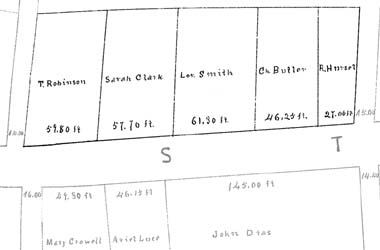 1873 Assessors
Map
1873 Assessors
Map
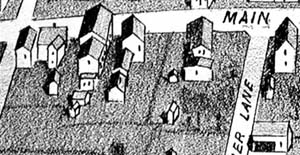 c. 1887 (north
is left)
c. 1887 (north
is left) 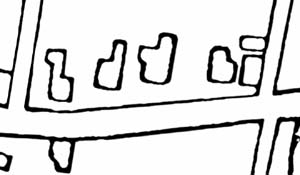 c.
1888
c.
1888
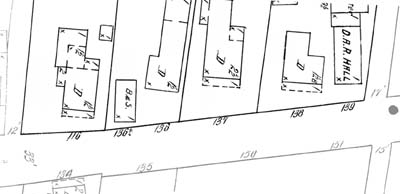 1914 Sanborn Map
1914 Sanborn Map
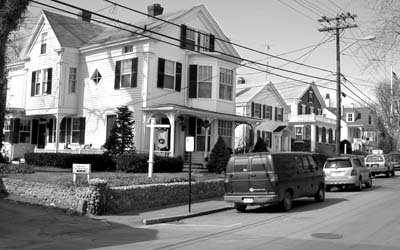 March 2002
March 2002
The great 1883 fire was stopped from spreading further north by a northerly
breeze and by narrow Drummer Lane. According to family legend, this lane
was named after Dr. William Leach's horse. (See Site #8 for more about
Dr. Leach, who lived at the top of Drummer Lane.)
Because they were spared from the blaze, the houses north of Drummer
Lane predate 1883, some by more than a century. The history of these old
homes has been published in earlier works, including Jim Norton's excellent
book, "Walking in Vineyard Haven, Massachusetts" (2000).
As these buildings are outside the immediate scope of this history and
were mostly private homes, I will only give a brief summary of their histories
here.
I have cross-referenced the following notes with Norton's numbering
system. Consult his book for more information.
36. The "Capt. Dexter House" (Norton cross-reference: #76 "Rudolphus
Dexter House")
Stan Lair said in 1979: "The
first house on that west side is the Rheno house, one time was owned by
Laura Robinson, and is operated now by Mrs. Rheno as a rooming house."
Capt. Rodolphus W. Dexter's House (1843-1866)
In 1843, the widow and children of Thomas Manter (c1776-1821) sold
this unbuilt lot to Tisbury mariner Rodolphus W. Dexter (1816-?).
According to Norton's book, Capt. Dexter hired contractor James Peakes to
build the house here in the 1840s.
Capt. Dexter was born in Tisbury, the son of Benjamin Dexter and Betsy
Hillman, and the husband of Irene/Irena Clifford (1819-?). (He was
also the brother of Capt. George Dexter, whose widow and daughter lived
at Site #29.) Dexter and his family
were living in this house by 1850, and remained here until 1866, when they
sold this property to Thomas Robinson and then moved out of town.
Capt. Thomas M. and Laura Robinson's House (1866-c.1909)
Capt. Thomas M. Robinson (c1833-1876) and his family lived here
next. Robinson was born in Tisbury, the son of Hervey Robinson and Peggy
Manter and the husband of Laura Crosby (1838-1909) of Edington Maine.
They adopted Aleta T. Robinson, who later ran the successful dry goods business
at Site #30. Capt. Robinson died in
1876, and Laura and "Leta" remained in this home until Laura's
death in December 1909.
Mrs. Mary Bradley, George and Nellie Dean (1910s-1920s)
The next few owners and occupants are unclear. Mrs. Mary A. (Bradley)
Beetle (1845-1922) evidently became the owner of the property and lived
here in the 1910s and in 1920. She was the daughter of storekeeper Charles
Bradley and his wife Nancy Athearn (see Site #22). George H. Dean and his
wife Nellie (Horton) Dean (daughter of Murray W. Horton) evidently held
the deed in 1923. Stan Lair wrote on the 1914 map for this house, "Mrs.
Simon Rheno -- Roomers --- (Beetle House)"
Winthrop C. and Myrtle Rheno's Home (Before 1920-1981)
By 1920, Winthrop Rheno and his mother Clara were living here, and in 1923
Rheno bought the house from the Deans.
Stan Lair said: "Winthrop
Rheno, Win Rheno. He was foreman for Hancock for a good many jobs. Construction
foreman. We always liked to work for Winny Rhino because when you got on
the job, the first thing he asked you was "Where do you want your
holes?" I was a plumber, by the way, so we had a lot of holes to cut.
And Winny would say "Where do you want your holes?" and he would
give you a man to cut the holes for you. If you happened to have a house
that had crawl space under it, Winny would see that the place was lit,
he would have electric lights under there with switches. No drop lights
or anything like that, you just throw a switch and boy, you were working
right there in real comfort. He was quite a foreman."
House carpenter Winthrop Clarence "Winny" Rheno (1897-1963)
was the son of Mrs. Clara May (Pratt) Rheno (1861-1932) and her husband,
contractor and cabinetmaker Simeon L. Rheno of Maine (c.1858-9 - 1926; see
Site #13). Winthrop was also the brother of a World War I hero, Lieutenant
Walter Davis Rheno of the Lafayette Escadrille.
Clara was born in Hingham, and lived in Boston for many years after her
marriage. She moved to Vineyard Haven about 1894. After many years of separation,
her husband Simeon died in Tewksbury in 1926 (possibly in the State Infirmary
or the State Poor Farm which were both located in that town.)
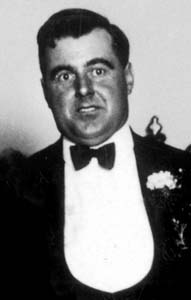 Winthrop Rheno at a Masonic
gathering.
Winthrop Rheno at a Masonic
gathering. 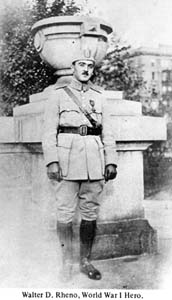 Walter Rheno
Walter Rheno
The 1930 Vineyard Haven census lists 32-year-old Winthrop C. Rheno as
a single carpenter and contractor living with his 68-year-old widowed mother,
Clara. Their home was valued at $9000.
Winthrop's niece Carolyn Furtado wrote: "Win and Myrtle met and carried on a correspondence for several
years and then tied the knot. She was from Kansas and had been a schoolteacher.
My great-grandmother Clara's name was Pratt, daughter of Benjamin F. Pratt
of Weymouth. She married first, Eugene Burleigh Young of Hingham, having
two daughters, my grandmother Mary Adelaide, and Lillian. When my grandmother,
May (Clara was Clara May), was twelve years old, Clara up and left Eugene
and the girls and remarried to Simeon Rheno. I think my mother said he
was a musician, but I can't verify that. Simeon was born to a family named
Davis in Maine, and later was adopted by the Rheno family who treated him
with great cruelty, and evidently must have wanted him for a slave."
Upon Winthrop's death in 1963, the house was inherited by his widow Myrtle
Rheno (1905-1996) who operated her home as a rooming house. She sold
the property to Charles Rechtsteiner in 1981.
Modern Owners
In 1981, Rechtsteiner sold this property (listed as "100 Main Street")
to Beyer and Patricia Parker.
In 1988 the Parkers sold it to Steve Pieczenik, who in 2000 was
operating the home as a bed-and-breakfast under the name of its first inhabitant,
the "Capt. Dexter House."
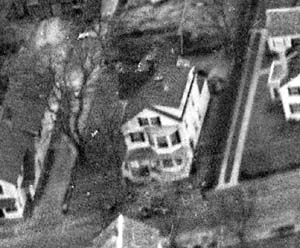 Rheno House, Aerial
View. Photo c. 1947 by pilot Walter Hume Renear
Rheno House, Aerial
View. Photo c. 1947 by pilot Walter Hume Renear
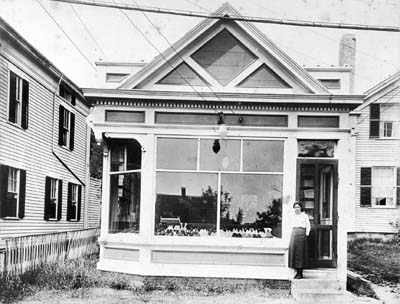 On the back of this photo is written "Ellis
Manter's Shoe Store - next to the Rheno House (Captain Dexter) in what is
now Mrs. Mayhew's driveway." The photo is stamped "Douglas Photo,
Oak Bluffs, Mass. Aug. 23, 1920." His job printing shop was in the
rear. This photo may have been taken just after Ed Lord took over the shoe
business.
On the back of this photo is written "Ellis
Manter's Shoe Store - next to the Rheno House (Captain Dexter) in what is
now Mrs. Mayhew's driveway." The photo is stamped "Douglas Photo,
Oak Bluffs, Mass. Aug. 23, 1920." His job printing shop was in the
rear. This photo may have been taken just after Ed Lord took over the shoe
business.
37. Ellis Manter's House and Shop
(Norton cross-reference: #75 "Timothy Pease House")
More than once in the history of this property there was a store building
perched on the edge of the street, separate from the main dwelling house.
The following notes relate to both the house and the store.
Stan Lair said in 1979: "Then
we come to the E. H. Manter Shoe Store, which has since been moved. It
was right on the corner of the next lot, though. That building was moved
all over the place, and finally wound up down on Lagoon Pond Road, where
it is the Color Center. And the house on that property was the E. H. Manter
house, now belongs to Mrs. Mayhew. Also, Dr. Merchant lived there at one
time."
Stan Lair and Ralph Look in conversation:
RL: …and then Ellis Manter, see.
SL: That was Manter's shoe store.
RL: Right! This town right now has quite a little money left that Ellis
Manter left to the town for children. Sure! Quite an item in the town report
about it. Should be!
Sarah (Pease) Clark's Property (1838-1874)
According to Mr. Norton, Timothy Pease's family bought this lot in 1838,
and in an 1843 deed it is referred to as the property of his daughter Sarah
S. Pease (1798?-1874). Sarah was born in Farmington, Maine. In November
1848, at the age of fourty-four, she married widower, stone-cutter, and
mariner Jonathan Clark (1796?-1856) of Dennis and Rochester, the
son of Jonathan and Deborah Clark. It's unclear when Sarah and Jonathan
Clark built the house here, or when they may have lived in it. According
to Norton, the house was used for "transient housing." Jonathan
Clark died of "consumption" (tuberculosis) in 1856.
Heald's Shoe Shop and Home (1840s? - before 1858)
There is evidence that Tisbury shoemaker John Heald of Farmington
Maine may have had a shoe shop here in the 1840s. He died of dysentery in
October 1849 at the age of fifty-eight, and his son Zachariah N. Heald
(1821-?) took over the shoemaking business.
The 1850 census shows the Heald family living in this house, headed by
Zachariah Heald's widowed mother Hannah Smith (Norton) Heald (1795-?),
the daughter of Zachariah Norton and Hannah Smith of Edgartown and Farmington.
In 1850 Mrs. Heald lived here with her ten children, son-in-law, and granddaughter.
In October 1852 the Gazette reported that Zachariah N. Heald of Tisbury
married Elizabeth S. Norton of Farmington, in Farmington. They returned
to the island and were listed in the 1855 Tisbury census, but the entire
Heald family evidently left the island by 1860.
The 1858 map lists a separate "Shoe Shop" building at this
location, although the dwelling house is marked as "J. Gray".
James Gray's Rental (late 1850s - 1860s)
Capt. James Gray (1814 - ?) was evidently living here in 1858
and 1860. He was born in Starks, Maine, the son of James Gray and Elizabeth
Norton, and was the husband of tailoress Sarah B. Harding (c1820
- 1902) who was the daughter of William Harding and Abigail Baxter, and
the sister of Capt. Ephraim Harding of Site #33.
They evidently moved out of this house before 1870.
"Kitchen" School?
(Years uncertain, but probably mid-1800s)
A Gazette profile of Ellis Manter (1856-1933), who
later owned this house (see below), describes his early education in Holmes
Hole: "Mr. Manter was sent to the public
schools when they were in session, which was but six months out of the
year. But when these were closed, he attended classes in the famous old
"kitchen" schools which were conducted privately and under severe
handicaps as reckoned by present day standards, but which were marvelously
efficient. It was in one of the old kitchens of the village that he learned
geography, a study that he has never forgotten because of the thoroughness
with which it was taught. It is interesting to note that the kitchen of
the house in which Mr. Manter now lives, and owns, is a part of one of
these old schools."
Rev. Hawkes' Rental (c. 1870)
In 1870 Methodist clergyman Rev. Philo N. Hawkes (1808-1891) was
evidently renting this house with his wife and daughter. Hawkes was pastor
of the Holmes Hole Methodist Church from 1870 until 1872. Born in Charlemont,
Mass., he was a clergyman in Lowell by 1850, then served as a chaplain of
a Rhode Island regiment during the Civil War. He was married to Gratia
Electa Field (1813-?) of Gill, Mass. He died in Barnstable and is buried
in Bristol, RI.
Thurston Tilton's Ownership (1875-1876)
In July 1874, property owner Sarah N. (Pease) Clark died. (The town
record listed her cause of death as "dementia.") The following
year her stepson Cornelius Clark sold the property to schoolteacher Thurston
W. Tilton for $1100.
Mary and Ellis Manter's Home (1876-1933)
In 1876, Thurston Tilton and his wife Agnes sold the property for $1200
to Henry Manter. The deed included the buildings on the property
"excepting a Shop or Store and walls and underpinnings thereof"
- evidently referring to former shoe shop building.
It is not yet been discovered what Tilton did with the store, or what (if
anything) the building had been used for since the Healds left. The store
building does not appear in the 1887 birdseye map, nor in the 1888 real
estate map.
Seaman Capt. Henry H. Manter (1816 - 1879) was born in Tisbury,
the son of ____ and the husband of Mary C. Luce (c.1821-1905; the
daughter of David and Priscilla Luce) of Chilmark. He died in February 1879,
just a few years after buying this home. The 1880 census lists the widow
Mary here with her 24-year-old son, Ellis H. Manter (1856-1933),
who by this time was working as a "job printer." Ellis had formerly
been a student of the Grove Hill Seminary on Crocker Ave. In March 1882
the Gazette noted "E. H. Manter, the job printer, has added a new branch
of business - oyster merchant - with his tried and faithful assistant F.
Daggett."
Ellis Manter went on to become the proprietor of a successful boot and
shoe shop that doubled as a job printing shop (see Site #3). He had opened
his first shoe store and print shop in town for just a couple of months
when the 1883 fire burned it down, and he temporarily relocated his store
at his home at this site.
His obituary notes:
"As a boy he entered one of the general stores as a clerk, but being
ambitious to own his own establishment, set up in business with a small
stock of notions and a few shoes before he was twenty. His first stick
was hardly on the shelves when the Vineyard Haven fire occurred, and because
of the small amount of goods in his place of business, he was able to transfer
them to a place of safety. On the following day there was a great demand
for shoes, which he was able to supply, but as no one had any money, he
was obliged to extend credit.
"This was a peculiarly unfortunate circumstance,
as he had purchased his stock on credit and had agreed to make payment
on a certain date. In order to fulfill his promise, Mr. Manter dug shellfish
and sold them to pay for his stock of shoes, and thus established a line
of credit with wholesalers that never failed during the forty years that
he remained in the shoe business.
"From early boyhood, his hobby was printing, and
he practiced during his spare time with printing presses of various sizes
until at last he became the possessor of a fairly large machine upon which
he turned out work that gained for him a wide reputation for accuracy and
excellence. He thus attracted the attention of Edson C. Crick, who published
the Vineyard Haven News, the only newspaper ever printed in Vineyard Haven.
This was printed by Mr. Manter."
Manter once again opened a downtown shop after the fire (see Site #3),
but between about 1910 and 1914 he is said to have obtained the small shop
on the corner of Union and Main Streets and moved it back onto his property
at this site. It was out of this shop he worked until his retirement.
In 1900, a few years before the death of his mother, he married Ethel
L. McKenne, whom he divorced before 1910. The 1910 census lists Ellis
Manter living alone in this house, and in 1920 with a house full of borders.
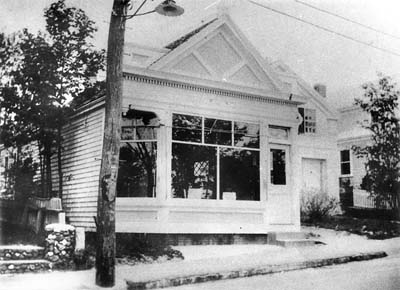
Stan Lair wrote on the back of this photo: "Manter's Shoe Store, next to Rheno's - was moved from here
to the rear of Cronig's store, then to the post office parking lot, to
across Lagoon Pond Road. It is now the Island Color Center."
Walter Renear added: "This
building was on Main Street (second building north of Drummer Lane, west
side of Main). This building was moved to the lot where the Post Office
is now and then when the First National Store was built it was moved to
the east side of Lagoon Pond Road. And there it now sits as the 'Island
Color Center.' In its original location it may have been Lord's Shoe Store."
| The Many Incarnations of Manter's Shop |
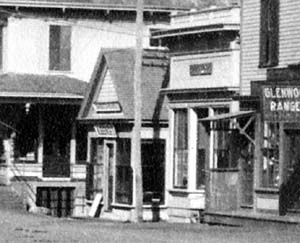 Location #1?: Southeast corner of Main and Union.
Location #1?: Southeast corner of Main and Union.
Before it was Manter's shop, it is said to have been
this small shop on the left, where an empty lot lies today (See Site #5.)
Photo circa 1905.
Stan Lair wrote on this photo: "Note
the extra building at 'Carter Park' location. It was moved next to Mrs.
Rheno's as Manter's Shoe Store - Then moved to back of Cronigs Market on
Church St. as a restaurant - Then moved to the present Post Office Lot
next to John's Fish Market (corner of Lagoon Pond Rd. + Beach St.) Then
moved to its present location on Lagoon Pond Road."
|
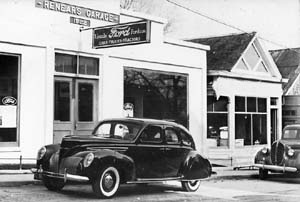 Location #3: North side of Church Street.
Location #3: North side of Church Street.
Manter's shop after it was moved to Cronig's property.
This photo is from the 1939 Renear's Garage calendar.
Bob Renear wrote: "The
building next to the garage was Manny Caton's gas (bottled) sales and service.
It was also Jeanette's Restaurant for awhile. Then the building was moved
to Howard Avenue and became Mike Fontes' paint store."
|
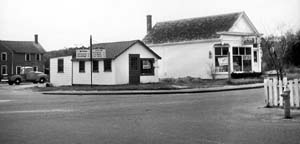
Location #4: South side of Beach Street.
Stan Lair wrote on the back of this photo: "John's Fish Market and Mike Fontes' Paint Shop (Vineyard
Color Center) on the corner of Beach Street and Lagoon Pond Road (Post
Office Lot). The paint shop was moved from here to its present location
on Lagoon Pond Road."
|
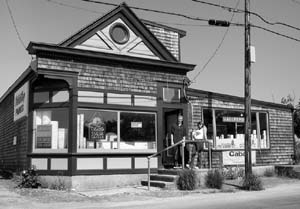 Location #5: East side of Lagoon Pond Road.
Location #5: East side of Lagoon Pond Road.
Island Color Center, Lagoon Pond Road, June 2002. Elias
Ingraham (owner Bill Ingraham's son) and Megan Stiller (Sam Cronig's great-granddaughter)
stand outside. |
Stan Lair said: "The
building on the corner of Main and Union, now Carter Park, was a fish market.
It was also Schwemmler's Bakery, Ashton's Photographers' Shop, Matthew's
Real Estate, with a small store in the front, and a former Barnacle Club
headquarters. It was moved to a spot next to Rheno's, next to Mrs. Rheno's,
around the corner of Mrs. Mayhew's property, where it was E. H. Manter's
Shoe Store with a job printing shop in the back. It was moved from there
to the rear of Cronig Brothers' store where it was a restaurant operated
by the LeBell Family, and then a printing shop later operated by R. W.
Martin. It was moved from there to the present Post Office parking lot,
on the corner of Lagoon Pond Road and Beach Street, where it remained for
three years and then was moved to its present location, the Island Color
Center."
Walter Renear explains:
"The building that was in what was called "Carter's Park,"
the southeast corner of Main and Union Street, got moved about something
like this:
(1) At the southeast corner of Main and Union Streets
(2) Main Street, west side, immediately north of Mrs. Rheno's-that is the
second building north of Drummer Lane.
(3) In what is now the parking lot for Cronig's Block, that is on the north
side of Church Street between Renear's Garage and Cronig's corner building.
While at this site it was the used as restaurants for "Ma Block"
and "Jennett's" and may also have been one of the locations of
'Stam's Bakery.'
(4) The lot where the Post Office now stands, it was moved from here to
make way for the First National Store (which was the original use of the
Post Office Building); at this time it belonged to Mike Fontes and he used
in his paint business.
(5) Lastly it was moved to the east side of Lagoon Pond Road directly opposite
the exit to the Post Office Parking lot; first housing Mike Fontes paint
business, then James Beckman's paint business and finally the present business
of Island Color Center."
Mike Fontes Jr. adds: "I
know that my father's paint shop was moved at least four times, and I have
heard that it was once a shoe store, and was fronted on Main Street in
one of its many "incarnations". I recall hearing about the location
near Drummer Lane, but this was all before my time! I am sure that if my
father testified that the building was once where the site of the old police
station (the station previous to the one at the top of the A&P parking
lot) then I know that it must be so, as my dad was alive during this building's
many moves!"
The Vineyard Shoe Store (Ed Lord) (1920-?)
By 1920, the aging Manter had retired from the shoe business, and while
he continued to live in the house and set type on his presses, he rented
out the front of his shop.
In the summer of 1920 The Vineyard Shoe Store began advertising.
Edward Clifton Lord (1858-1934) was the proprietor.
Lord had formerly owned and operated the ship chandlery on Grove Street.
See Site #32 for more about Lord.
James Lee's Gas Range Shop (1928)
In March 1928 the Gazette reported that James Lee had opened up for
business in "the Ellis Manter Shop." In May he advertised as a
"gas range dealer" It's not clear how long he remained at this
site. (See Site #23 for more on Lee
and his business.)
James Winchester Lee (c1878 - 1958) was born in Long Island, the son
of Cornelius and Mattie Blood Lee of New York City. His obituary notes that
"In 1903 James W. Lee arrived in West Tisbury from New York with the
first automobile to be owned in that town." A 1928 article noted that
this was actually the second car on the island, and that he also brought
the island's first motorcycle here, and later suffered a debilitating motorcycle
accident in New Zealand. He was also one of the first island owners of a
speedboat. By 1928 he was living in Joshua Slocum's former home in West
Tisbury. He eventually retired to Florida. In May 1929 an advertisement
in the Gazette announced: "The Vineyard agency for Protane Gas and
Gas Stoves formerly conducted by James Lee, has been taken over by [Henry
Cronig], who is equipped to supply service and gas…."
It's not clear who, if anyone, occupied the store between 1929 and 1933.
One person remembers that Leonard G. White (c.1891-2 - ?), usually
referred to as "White the Electrician," may have had a shop here
about this time, but memories of White's location vary. His shop had previously
been in "Andrews Block" (see Site
#26), and his business was eventually bought out by Brooks Carter. Len
White was described in a 1932 column as "noted for his heavy thatch
and fifty pounds of electrical tool sticking out of his pockets."
The 1930 census lists 73-year-old divorcee Ellis H. Manter living in
his home here and still working as a printer. His home was valued in this
census at $17,000, and he rented part of his house for $30 per month to
Frederic E. Magee, his wife Maud, and their son Crichton.
At this time Fred and Crichton worked as salesmen in the furniture department
of L. E. Briggs' store (see Site #31.)
Fred had formerly been the manager of the Ginter store (see Site #3.)
When Manter died in March 1933, his (ex?)wife left money from his estate
to the Tisbury School as a "shoe fund," which is still drawn upon
to this day to help shoeless children to buy school supplies. His house
was sold to Ella D. and Raymond F. Merchant. The Gazette reported
in June 1933 that Dr. Merchant had then sold Manter's store building to
Henry Cronig, and that the building was to be moved to Church Street by
Henry Cronig. The following week the Gazette reported that W. E. Dugan had
been awarded the contract to remodel Dr. Merchant's new house, noting that
"the office and consulting room will be incorporated with the living
apartments in the newly purchased home. Mr. Dugan will also repair and equip
the store building recently purchased and moved from the Ellis Manter property
to Church street. And speaking of moving the store, most of the work was
done at night, and movers and telephone men, especially Henry Counsell,
put in a thirty-hour shift."
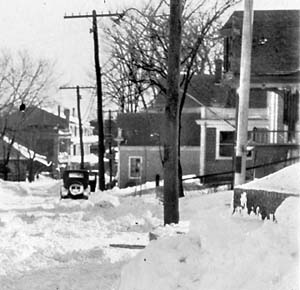
Manter's shop can be seen at the center of this snapshot,
taken from near the bottom of Colonial Lane. This photo was marked "Feb.
10th" - suggesting that this was probably the Feb. 10, 1926 snowstorm
which the Gazette called "the hardest blizzard in 20 years." |
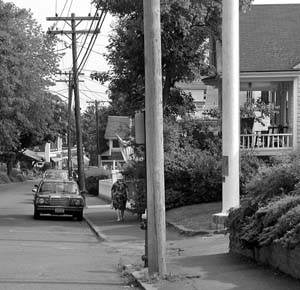 The same view, 76½ years later, June
2002. No shop.
The same view, 76½ years later, June
2002. No shop. |
 The Manter House
(sans shop), March 2002
The Manter House
(sans shop), March 2002
Dr. Merchant's Home (1933-1943)
John Canha on Dr. Merchant:
"Dr. Merchant was my doctor, removing my tonsils by electric-coagulation.
I would visit his office weekly for tonsil treatment. It was next to the
DAR building on Main St. Before he finished with me, he had an appendix
operation, the day he sat up in the hospital bed talking to his wife, he
fell back dead."
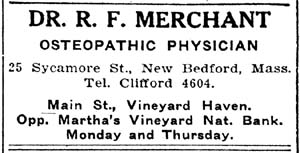 Dr. Raymond Francis Merchant
(c1901-2-1943) moved here from New Bedford about 1928 and began a medical
practice in Vineyard Haven. He was born in New Bedford, the son of Ambrose
F. Merchant, and was a graduate of New Bedford High School, class of 1919,
and the Chicago College of Osteopathy, class of 1925. He served his internship
at Columbia Hospital in Chicago. In July 1929 he married Ella V. Deslandes
of New Bedford.
Dr. Raymond Francis Merchant
(c1901-2-1943) moved here from New Bedford about 1928 and began a medical
practice in Vineyard Haven. He was born in New Bedford, the son of Ambrose
F. Merchant, and was a graduate of New Bedford High School, class of 1919,
and the Chicago College of Osteopathy, class of 1925. He served his internship
at Columbia Hospital in Chicago. In July 1929 he married Ella V. Deslandes
of New Bedford.
By January 1929 Dr. Merchant's office was on Union Street in Lane's Block
(see Site #4), where he advertised as an "osteopathic physician"
and in 1930 advertised a treatment for varicose veins. Although initially
he leased the house of Edward H. Smith, in 1933 he bought the home at this
location from Manter's estate.
Dr. Merchant died June 7, 1943 following an attack of appendicitis, at
the age of 41. His obituary notes, "His home, formerly the Ellis Manter
house, on Main Street, was a source of pride to the owner."
Modern Owners
Mrs. ____ Mayhew owned this house in the 1970s, and Edith Hurd
owned this house during the 1990s.
38. Lorenzo Smith's House (Norton
cross-reference: #74 "John Howland, Constant Downs House")
Stan Lair said of this house: "The
Dan Alisio house, at the present time. Ida Luce lived there. She worked
for Ernest Tilton for a good many years. Also a Dr. Bullitt owned it for
awhile."
According to Norton, this house was built by carpenter John Wing Howland
(1814-1896) shortly after he purchased the lot from Danish mariner John
Swain in 1840, and sold it two years later to Capt. Constant Downs
(1807-1891).
Capt. Lorenzo Smith's Home (Before 1850 - 1896)
By 1850 this house was evidently occupied by Lorenzo Smith (1815-1896),
his wife Christina B. Dias (1818-1896), and their children. Smith
was the son of Elijah Smith and Lydia Clifford, and his occupation was listed
variously as "mariner", "seaman", and "ship master."
The family of Nantucket mariner Edwin Baldwin lived with them in
1850, and deaf seamstress Sophronia Wade boarded with the family
in 1865.
Capt. Smith died in October 1896, and his wife just two months later.
The house was inherited by their unmarried daughter Florence Alton Smith
(1847-1925), who lived at home. Miss Smith probably continued to live in
the house by herself until between 1907 and 1910, when she moved in with
her cousin-in-law Hartson Bodfish, and then rented out her childhood home.
Following her death in 1925, the property wound up in Dukes County Land
Court.
Ida Luce's Rental Home (1910)
By 1910, hardware store saleswoman Ida M. Luce (c1871-2-?) was living
here with her widowed mother Content (Cottle) Luce (1840-1923). Content
was the daughter of Tisbury farmer Edmund Cottle and his wife Content. Her
sister Eliza was the mother of hardware merchant Ernest Tilton (see Site #29), whom Ida worked as a clerk
for.
Dr. Bullitt's Home (1925)
In August 1925, following the death of homeowner Florence Smith and the
subsequent Land Court trial, John C. Bullitt Jr. and his wife Edna
D. Bullitt of Wayne, Penn., claimed the title to this property.
Dr. John Christian Bullitt, 2d (1871-1925) used this house as a summer
home. He was the son of prominent Philadelphia lawyer, banker, and railroad
tycoon John C. Bullitt and his wife Therese Langhorne. Dr. Bullitt was born
in Philadelphia, graduated from the University of Pennsylvania, and received
his medical degree from the Pennsylvania Medical School. He practiced medicine
for many years in Philadelphia. The 1910 census of the Norwood, Penn. lists
him as a 38-year-old divorced physician boarding with a family there, and
in 1911 he married Edna Deaver. In 1918 they began summering on the Vineyard.
He died in October 1925, only a few months after obtaining the house,
at the age of 52 in Vineyard Haven. He is buried in Wayne, Penn. His obituary
notes that "He had taken great interest in remodeling the old Capt.
Lorenzo Smith house, which he purchased some time ago, and which he intended
for his own use. The house is nearly complete."
According to the book "My Life at Oxmoor / Life
on a Farm in Kentucky Before the War" by Thomas W. Bullitt:
"John Christian Bullitt (1871 - 1925) was the youngest child. He was
somewhat retarded, but did succeed to graduate from medical school, perhaps
due to his father's influence. He never practiced. He married first in
1899 Josephine M. Zinque, and the marriage was annulled the same year.
In 1911, he married Edna A. Deaver, in spite of the opposition of his family,
which led to a lunacy hearing. The family was bitterly divided over this.
William, Joseph and Helen maintained that he was mentally competent, while
Julia and Logan pressed the action. Therese was on neither side, deploring
the family controversy. The court found in favor of John's competence."
Dan Alisio's home (1970s-1990s)
Barber Dan Alisio is remembered to have bought this house with his
wife Marguerite by the 1970s, and he lived here until shortly before
his death in 2001. See Site #3 for more on Alisio.
 June 2002
June 2002
39. Shubael Vincent's House (Norton
cross-reference: #73 "Malachi Baxter House")
Stan Lair said: "Next
was Shubael Vincent, he was father of Frank Vincent. Frank Vincent had
the cat boat, the On Time. In fact he had two of them, I believe. And he
would bring over our Sunday papers, take parties out for sails, and was
always for hire-anyone who wanted to get over to the mainland."
Old Houses in Vineyard Haven 1712-1830 compiled by
the Tisbury Tercentenary Committee noted:
"Owner, Mrs. Frank Vincent. The house is obviously a very old one,
excellently kept up. The early part dates from the return of a Revolutionary
soldier, Malachi Baxter, after fighting at Bunker Hill. The present owner's
husband was a descendant of Baxter through his daughter and granddaughter.
Except for the addition of the piazza, there have been no structural changes
in the house since it was built here."
The Butler Family Home (1830s - 1895)
According to Norton's book, this house was built in 1778 for blacksmith
Malachi Baxter and his wife, schoolteacher Rhoda Manter. Originally located
on the corner of Drummer Lane (near Site #36?), it was moved here during
the 1830s for their daughter Betsy (Baxter) Butler and joined with a second
house in the rear. Mrs. Butler, a seamstress, bought this lot from carpenter
James Cottle (1784 - 1863) in July 1830.
Betsey Baxter (1794-1867) married three times, to Thomas Harding
(1784-?) in 1808, then to ____ Butler, and finally to Edgartown yeoman Ichabod
Norton (1786-1860) in 1857. She died a widow in May 1867 of a fever.
In the 1850 census, Betsey lived in this house with her brother John
Baxter (1780-1858), a widower. Shortly afterwards John moved to West Tisbury,
and Betsey is probably the "Betsy Norton" who appears alone in
the 1865 East Tisbury census. The 1858 map of Holmes Hole shows this house
marked as "Betsey Butler"
Following Betsey's death the house was inherited by her son, teamster
Charles D. Butler (1816-1895), who moved in with his wife Love
Pease (1824-1891) and their children by 1870. The 1873 assessor's map
shows this house marked as "Ch. Butler."
The Vincent Family Home (1870s - 1990s)
Mrs. Eveline Francis (Butler) Vincent (1846-1921), daughter of
Charles and Love Butler, inherited the house following the death of her
parents. She had lived here since her teenage years, and in 1877 she married
fisherman and carpenter Capt. Shubael L. Vincent (1842-1926). Her
brother, painter William Harrison Butler (1848-1910), and her disabled
sister Sarah D. Butler (1850-1912) also lived in this home with them.
Capt. Vincent was born at Chappaquansett, the son of Isaac Vincent and
Emeline Luce. His obituary notes that "At a very early age he went
to sea and sailed in the merchant service for many years, visiting nearly
all the principal European ports as well as those of this country and South
America. Returning to the Island he married and made his home in Vineyard
Haven, while engaging in the coasting and fishing, being master of his own
craft until failing eyesight forced him to remain ashore. His last occupation
was that of carpenter…"
Stan Lair speaking about the aftermath of the 1918
wreck of the Port Hunter, which was rammed and sunk by a tugboat on Hedge
Fence Shoal:
"…Well, one of the hatch covers apparently came loose and the
cargo began to float around. That's when we got the word that the cargo
boxes were coming ashore on the north side of the Island. So a bunch of
us boys headed down toward the Herring Creek, about a three mile walk through
the woods. And we arrived there, and sure enough, there were all sorts
of things coming ashore in boxes.
"There was a man, an old gentleman right ahead of
us, going along, pulling stuff up, his name was Shubael Vincent. He was
putting his initials on every box that he came along, 'S. V.', 'S. V.',
throwing them up into the bushes and the boys were coming along right behind
them and picking them up and making off with them!
"There was all kind of stuff coming ashore there.
There was of course soap, and candles, shoe dubbin. That was about all
the stuff that would float there, of course a lot of the stuff was taken
out of the holds later. For a time there was 'finders keepers,' and fishermen
were bringing leather jerkins into the town wharf, and selling them right
off the boats for a dollar apiece. Two dollars each for the black ones
which were rare ones, prize ones, I guess. Dollar each for the others.
And they were bringing those things in by the hundreds. They were packing
bales of a hundred."
Mrs. Vincent died in her home here in April 1921 and her husband in 1926.
They were the parents of newspaper store owner Charles Morton Vincent
(see Site #27) and carpenter and
boatman Francis Chetwood "Frank" Vincent (1877-1949), and
it was Frank who inherited the home next. In 1930 the house was valued at
$6000.
After Frank's death in 1949, the house was inherited by his son, Francis
Chetwood "Frank" Vincent Jr. (1927-)
Since 1994 the property has been owned by Mary Etherington.
 June 2002
June 2002
 40.
THE DAR (Norton cross-reference: #72 School House Chapel)
40.
THE DAR (Norton cross-reference: #72 School House Chapel)
Stan Lair said in 1979: "Next
is the DAR building. Once was the Nathan Mayhew School, I believe in the
1820's, 1830's, along through there. Well, this is the site of the flagpole
that was blown up by the three girls during the Revolutionary War, so the
British wouldn't utilize it as a mast for their ship. These three girls
blew the pole up with gunpowder, and there was a plaque on the pole telling
all about it."
Mrs. Howes Norris described it in 1921: "The Mayhew Schoolhouse was erected about one hundred years
ago by Mr. Nathan Mayhew, for school purposes; but it was often used for
religious purposes."
The 1971 Tercentenary Committee described it: "The Nathan Mayhew School House was built in 1828 for a
'north end' school. It was built by Nathan Mayhew, who also taught the
school there for several years. On Sundays the building became the Congregational
Church, and the name 'Mayhew Chapel' has stuck to it. Eventually both school
and church found other quarters and the little building was given over
to business, until its purchase in 1903 by the Sea Coast Defense Chapter,
D. A. R. It holds an excellent small historical collection."
For the history of this and other early Vineyard Haven buildings in the
area, see James Norton's book, "Walking in Vineyard Haven, Massachusetts."
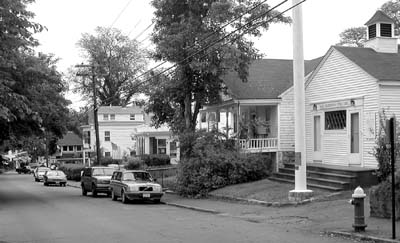 View from Colonial Lane toward town, June 2002
View from Colonial Lane toward town, June 2002
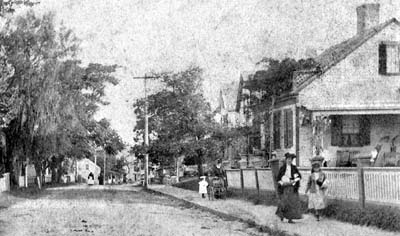 View toward town, taken from just north of what is now the entrance
to Owen Park. Photo by W. H. Ashton.
View toward town, taken from just north of what is now the entrance
to Owen Park. Photo by W. H. Ashton.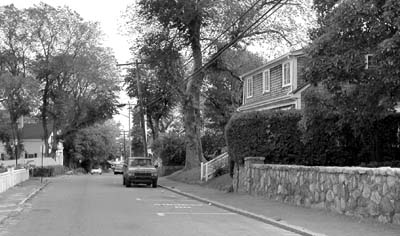 The same
view, June 2002.
The same
view, June 2002.
This is an unfinished draft! Do you have any memories of any of the
other people, places, businesses or events mentioned here? Or do you have
corrections, additions, or suggestions? Please contact Chris
Baer <cbaer@vineyard.net>
Return to Church Street to Drummer
Lane
Return to Tisbury History
 1858 Walling Map
1858 Walling Map
 1873 Assessors
Map
1873 Assessors
Map c. 1887 (north
is left)
c. 1887 (north
is left)  c.
1888
c.
1888



















